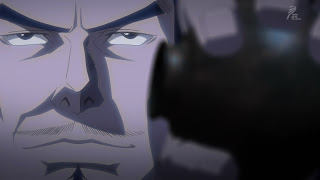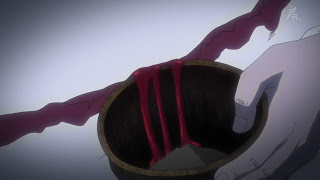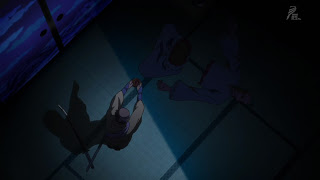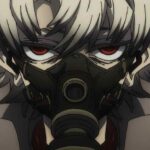![[Huzzah]_Hyouge_Mono_10_[2EB089CB].mkv_snapshot_03.41_[2011.12.02_20.01.40] [Huzzah]_Hyouge_Mono_10_[2EB089CB].mkv_snapshot_03.41_[2011.12.02_20.01.40]](https://lh5.ggpht.com/-lAvjzxx_AX0/Ttmtjh_xF_I/AAAAAAAAhkM/xmnEUax6h2o/Huzzah_Hyouge_Mono_10_2EB089CB.mkv_s%25255B23%25255D.jpg?imgmax=800) |
![[Huzzah]_Hyouge_Mono_10_[2EB089CB].mkv_snapshot_05.53_[2011.12.02_20.03.51] [Huzzah]_Hyouge_Mono_10_[2EB089CB].mkv_snapshot_05.53_[2011.12.02_20.03.51]](https://lh3.ggpht.com/-EFsCU3hqSJc/TtmtkrKX9-I/AAAAAAAAhkc/yJu7a30Ev-Y/Huzzah_Hyouge_Mono_10_2EB089CB.mkv_s%25255B41%25255D.jpg?imgmax=800) |
![[Huzzah]_Hyouge_Mono_10_[2EB089CB].mkv_snapshot_15.47_[2011.12.02_20.14.24] [Huzzah]_Hyouge_Mono_10_[2EB089CB].mkv_snapshot_15.47_[2011.12.02_20.14.24]](https://lh3.ggpht.com/-HR13NRj2BJo/TtmtlqDvsNI/AAAAAAAAhks/NoLjXsYOm0A/Huzzah_Hyouge_Mono_10_2EB089CB.mkv_s%25255B39%25255D.jpg?imgmax=800) |
This was another truly astonishing episode of Hyouge Mono, at turns surprising, moving and hilarious. It’s certainly safe to say there’s no other series like it.
It’s going to be a long time before I forget the opening scene, which picks up immediately where the last episode left off. The entire ep was full of brilliant cinematography, but the use of slow-motion and odd camera angles in this scene was enough to leave me speechless. I can’t do it justice by describing it, so you’ll just have to watch it. So much was portrayed here in a way that was truly horrible but also humorous in a deeply macabre way. It’s clear that Hideyoshi, the ultimate strategist, was truly stricken at what he’d done, though I don’t doubt he’d have done it again. The way this show blurs the line between reality and fantasy makes it hard to know if we were seeing events that were actually happening, or some sort of manifestation of Hideyoshi’s subconscious. In any case, Oda certainly made of the best exits in anime history.
 It looks as if Hideyoshi’s plan all along was to goad Akechi into murdering Oda, and then to do the deed himself once he knew the timing was perfect. I’ve no doubt now that we’ll see the events history tells us to expect – Hideyoshi marching on Kyoto to extract revenge on Oda’s “killer”, Akechi. What isn’t immediately clear to me is why Hideyoshi had to take the risk of doing the deed himself, rather than simply leaving it to Akechi to kill Milord. Perhaps he didn’t trust Akechi to do the job properly, or perhaps it was vital to him that there be no body (as he ensured with the stocks of gunpowder he’d stocked Honno-ji with).
It looks as if Hideyoshi’s plan all along was to goad Akechi into murdering Oda, and then to do the deed himself once he knew the timing was perfect. I’ve no doubt now that we’ll see the events history tells us to expect – Hideyoshi marching on Kyoto to extract revenge on Oda’s “killer”, Akechi. What isn’t immediately clear to me is why Hideyoshi had to take the risk of doing the deed himself, rather than simply leaving it to Akechi to kill Milord. Perhaps he didn’t trust Akechi to do the job properly, or perhaps it was vital to him that there be no body (as he ensured with the stocks of gunpowder he’d stocked Honno-ji with).
 There are several references to the “stone frog crying”, starting with the one that Oda uses to explain why he woke, and Hideyoshi laments that they would have secured Oda’s masterpieces were it not for the cry of the frog. Sasuke awakes too, miles away, convinced something has happened to Milord, and races towards Kyoto only to find Akechi’s men surrounding the city. Again, I’m not sure how much of this is meant to be taken literally, and how much is strictly symbolic, but it adds an interesting element to the aftermath of the murder. As Akechi’s men hunt down the warriors loyal to Oda (while mostly sparing civilians) Oda’s brother and son take refuge in Nijo Castle, but once Akechi allows the Imperial party to evacuate, there’s no escape for them. The son chooses ritual suicide, but brother chooses to live, dressing as a woman and luring the guardsmen out of his path with claims of treasures hidden in the palace.
There are several references to the “stone frog crying”, starting with the one that Oda uses to explain why he woke, and Hideyoshi laments that they would have secured Oda’s masterpieces were it not for the cry of the frog. Sasuke awakes too, miles away, convinced something has happened to Milord, and races towards Kyoto only to find Akechi’s men surrounding the city. Again, I’m not sure how much of this is meant to be taken literally, and how much is strictly symbolic, but it adds an interesting element to the aftermath of the murder. As Akechi’s men hunt down the warriors loyal to Oda (while mostly sparing civilians) Oda’s brother and son take refuge in Nijo Castle, but once Akechi allows the Imperial party to evacuate, there’s no escape for them. The son chooses ritual suicide, but brother chooses to live, dressing as a woman and luring the guardsmen out of his path with claims of treasures hidden in the palace.
 Even by this show’s standards the events following the murder and the destruction of Honno-ji aren’t going to inspire a lot of faith in human nature. Sosuke and Oda’s brother – still dressed as a woman – dig through the rubble of Honnio-ji looking for Nobunaga’s masterpieces, and only Sosuke deigns to go through the motions of grief. When Nobunaga’s bodyguard Yasuke arrives (just in time to save the pair from Akechi’s men) he offers them a bushel of treasures, and both men’s eyes light up in orgiastic joy at the prospect. There’s so much subtlety in this show, and as much as with any anime I feel strongly that there are elements I simply don’t fully grasp by nature of not being Japanese. But it seems to me that a comment is being made here about the nature of the aesthete and the nature of the warrior, and how our perceptions of who might be the crueler of heart might be misguided. No one’s hands are clean in this affair – ironically, it’s probably Akechi whose motives are the most idealistic, even as he sets off to commit treason and murder.
Even by this show’s standards the events following the murder and the destruction of Honno-ji aren’t going to inspire a lot of faith in human nature. Sosuke and Oda’s brother – still dressed as a woman – dig through the rubble of Honnio-ji looking for Nobunaga’s masterpieces, and only Sosuke deigns to go through the motions of grief. When Nobunaga’s bodyguard Yasuke arrives (just in time to save the pair from Akechi’s men) he offers them a bushel of treasures, and both men’s eyes light up in orgiastic joy at the prospect. There’s so much subtlety in this show, and as much as with any anime I feel strongly that there are elements I simply don’t fully grasp by nature of not being Japanese. But it seems to me that a comment is being made here about the nature of the aesthete and the nature of the warrior, and how our perceptions of who might be the crueler of heart might be misguided. No one’s hands are clean in this affair – ironically, it’s probably Akechi whose motives are the most idealistic, even as he sets off to commit treason and murder.
![[Huzzah]_Hyouge_Mono_10_[2EB089CB].mkv_snapshot_08.27_[2011.12.02_20.06.44] [Huzzah]_Hyouge_Mono_10_[2EB089CB].mkv_snapshot_08.27_[2011.12.02_20.06.44]](https://lh6.ggpht.com/-UK-5HrSyiHI/TtmtmVZ7YnI/AAAAAAAAhk8/gJbqaRFfpHo/Huzzah_Hyouge_Mono_10_2EB089CB.mkv_s%25255B10%25255D.jpg?imgmax=800) |
![[Huzzah]_Hyouge_Mono_10_[2EB089CB].mkv_snapshot_08.56_[2011.12.02_20.07.13] [Huzzah]_Hyouge_Mono_10_[2EB089CB].mkv_snapshot_08.56_[2011.12.02_20.07.13]](https://lh3.ggpht.com/-izdxRtry0es/TtmtnFvh7FI/AAAAAAAAhlM/_nyZY9ME1oI/Huzzah_Hyouge_Mono_10_2EB089CB.mkv_s%25255B15%25255D.jpg?imgmax=800) |
![[Huzzah]_Hyouge_Mono_10_[2EB089CB].mkv_snapshot_10.01_[2011.12.02_20.08.18] [Huzzah]_Hyouge_Mono_10_[2EB089CB].mkv_snapshot_10.01_[2011.12.02_20.08.18]](https://lh4.ggpht.com/-2OgCaABSBfY/TtmtnxhnvuI/AAAAAAAAhlc/9OSowcAos5o/Huzzah_Hyouge_Mono_10_2EB089CB.mkv_s%25255B26%25255D.jpg?imgmax=800) |
![[Huzzah]_Hyouge_Mono_10_[2EB089CB].mkv_snapshot_10.59_[2011.12.02_20.09.16] [Huzzah]_Hyouge_Mono_10_[2EB089CB].mkv_snapshot_10.59_[2011.12.02_20.09.16]](https://lh6.ggpht.com/-nMdm8sBqxX0/Ttmto0GtoAI/AAAAAAAAhls/87J6YdajaVE/Huzzah_Hyouge_Mono_10_2EB089CB.mkv_s%25255B20%25255D.jpg?imgmax=800) |
![[Huzzah]_Hyouge_Mono_10_[2EB089CB].mkv_snapshot_11.54_[2011.12.02_20.10.11] [Huzzah]_Hyouge_Mono_10_[2EB089CB].mkv_snapshot_11.54_[2011.12.02_20.10.11]](https://lh3.ggpht.com/-fOL9adtifFE/TtmtpqmTq4I/AAAAAAAAhl8/hnX531DtUT8/Huzzah_Hyouge_Mono_10_2EB089CB.mkv_s%25255B16%25255D.jpg?imgmax=800) |
![[Huzzah]_Hyouge_Mono_10_[2EB089CB].mkv_snapshot_12.24_[2011.12.02_20.10.41] [Huzzah]_Hyouge_Mono_10_[2EB089CB].mkv_snapshot_12.24_[2011.12.02_20.10.41]](https://lh3.ggpht.com/-TAHnmH1ijck/TtmtqSUQ5UI/AAAAAAAAhmM/szHIRuu541M/Huzzah_Hyouge_Mono_10_2EB089CB.mkv_s%25255B22%25255D.jpg?imgmax=800) |
![[Huzzah]_Hyouge_Mono_10_[2EB089CB].mkv_snapshot_13.56_[2011.12.02_20.12.33] [Huzzah]_Hyouge_Mono_10_[2EB089CB].mkv_snapshot_13.56_[2011.12.02_20.12.33]](https://lh5.ggpht.com/-mI975su1wIs/TtmtrY8KgzI/AAAAAAAAhmc/zBasZRRF-Vw/Huzzah_Hyouge_Mono_10_2EB089CB.mkv_s%25255B13%25255D.jpg?imgmax=800) |
![[Huzzah]_Hyouge_Mono_10_[2EB089CB].mkv_snapshot_14.19_[2011.12.02_20.12.56] [Huzzah]_Hyouge_Mono_10_[2EB089CB].mkv_snapshot_14.19_[2011.12.02_20.12.56]](https://lh5.ggpht.com/-BdGxAt12a1Y/TtmtsPgDMFI/AAAAAAAAhms/HkLesI6Zqgs/Huzzah_Hyouge_Mono_10_2EB089CB.mkv_s%25255B27%25255D.jpg?imgmax=800) |
![[Huzzah]_Hyouge_Mono_10_[2EB089CB].mkv_snapshot_15.25_[2011.12.02_20.14.02] [Huzzah]_Hyouge_Mono_10_[2EB089CB].mkv_snapshot_15.25_[2011.12.02_20.14.02]](https://lh3.ggpht.com/-n6rSnmk5bmg/Ttmts19uFEI/AAAAAAAAhm8/4vRo1-WkJ6M/Huzzah_Hyouge_Mono_10_2EB089CB.mkv_s%25255B34%25255D.jpg?imgmax=800) |
![[Huzzah]_Hyouge_Mono_10_[2EB089CB].mkv_snapshot_16.41_[2011.12.02_20.15.18] [Huzzah]_Hyouge_Mono_10_[2EB089CB].mkv_snapshot_16.41_[2011.12.02_20.15.18]](https://lh5.ggpht.com/-QtLrQ5yHh18/TtmttiGFHOI/AAAAAAAAhnM/D8tikEuKjck/Huzzah_Hyouge_Mono_10_2EB089CB.mkv_s.jpg?imgmax=800) |
![[Huzzah]_Hyouge_Mono_10_[2EB089CB].mkv_snapshot_18.05_[2011.12.02_20.16.41] [Huzzah]_Hyouge_Mono_10_[2EB089CB].mkv_snapshot_18.05_[2011.12.02_20.16.41]](https://lh3.ggpht.com/-80ZYBcIK1dI/TtmtuiTT3WI/AAAAAAAAhnc/PtMq2RbInLc/Huzzah_Hyouge_Mono_10_2EB089CB.mkv_s%25255B40%25255D.jpg?imgmax=800) |
![[Huzzah]_Hyouge_Mono_10_[2EB089CB].mkv_snapshot_18.36_[2011.12.02_20.17.12] [Huzzah]_Hyouge_Mono_10_[2EB089CB].mkv_snapshot_18.36_[2011.12.02_20.17.12]](https://lh5.ggpht.com/-U0HlIwuRfIc/TtmtvRMySEI/AAAAAAAAhns/DengVKkQUMI/Huzzah_Hyouge_Mono_10_2EB089CB.mkv_s%25255B14%25255D.jpg?imgmax=800) |
![[Huzzah]_Hyouge_Mono_10_[2EB089CB].mkv_snapshot_19.07_[2011.12.02_20.17.44] [Huzzah]_Hyouge_Mono_10_[2EB089CB].mkv_snapshot_19.07_[2011.12.02_20.17.44]](https://lh5.ggpht.com/-58058InfGHc/TtmtwDnHBjI/AAAAAAAAhn8/hD9-G9spE7o/%25255BHuzzah%25255D_Hyouge_Mono_10_%25255B2EB089CB%25255D.mkv_snapshot_19.07_%25255B2011.12.02_20.17.44%25255D_thumb.jpg?imgmax=800) |
![[Huzzah]_Hyouge_Mono_10_[2EB089CB].mkv_snapshot_19.59_[2011.12.02_20.18.36] [Huzzah]_Hyouge_Mono_10_[2EB089CB].mkv_snapshot_19.59_[2011.12.02_20.18.36]](https://lh6.ggpht.com/-_CScntUGCCU/TtmtxFekp1I/AAAAAAAAhoM/ZOhcPZ1t_ZU/%25255BHuzzah%25255D_Hyouge_Mono_10_%25255B2EB089CB%25255D.mkv_snapshot_19.59_%25255B2011.12.02_20.18.36%25255D_thumb.jpg?imgmax=800) |
![[Huzzah]_Hyouge_Mono_10_[2EB089CB].mkv_snapshot_20.37_[2011.12.02_20.19.14] [Huzzah]_Hyouge_Mono_10_[2EB089CB].mkv_snapshot_20.37_[2011.12.02_20.19.14]](https://lh6.ggpht.com/-bkHpdlLSsVk/TtmtyP8s-sI/AAAAAAAAhoc/uM4RraMwlCk/%25255BHuzzah%25255D_Hyouge_Mono_10_%25255B2EB089CB%25255D.mkv_snapshot_20.37_%25255B2011.12.02_20.19.14%25255D_thumb.jpg?imgmax=800) |






Mushyrulez
December 22, 2011 at 1:28 amThis episode also raises the question of where Furuta's true loyalties lie – the first half had him deeply worried about Oda, but all feelings of misery were cast aside as soon as he saw the treasures offered by Yasuke. Is this the path of a true aesthete?